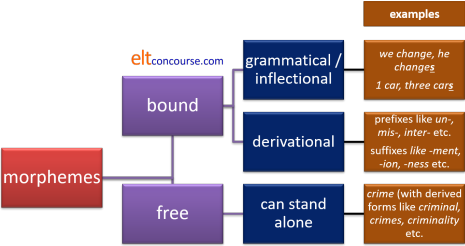What is a morpheme?
 |
| building meaning |
 |
The building blocks of meaning and grammar |
A morpheme is usually defined as the smallest meaningful unit of language. Morphemes are the building blocks from which we make words and some of the grammar.
Here are some examples of the first two main types.
Type
1 morphemes are underlined in red, Type 2 morphemes are
in bold green.
Can you see the difference?
Click here when you have an answer.
| boy | houses | smallish | keeper | window |
| cruiser | computer | glasses | washing | bombardment |
| unfortunate | disappearing | toasted | villainous | exceptional |
-
Type
1 morphemes can stand alone or form part of another word.
They are called free morphemes.
For example, the word small forms part of the word smallish but small is a word in its own right. The verb appear forms part of the word disappearing but can stand alone and have meaning. - Type 2 morphemes cannot stand alone. The morpheme ing forms part of the word washing but standing alone it has no meaning. There are two morphemes at the end of the word exceptional (ion and al) and neither can stand alone meaningfully. These are called bound morphemes.
Some morphemes can be both free and bound depending on their
function. For example, In the clause
I was able to go
the morpheme able is functioning as a word in its own right
but in
believable
the morpheme able is bound and makes the word believe
into an adjective.
In this course, we will be dealing with bound morphemes. Free morphemes will be considered when we come to analysing words.
 |
Two sorts of bound morphemes |
Here are some examples of the two kinds of bound
morphemes to consider. Again, Type
1 bound morphemes are underlined in red,
Type 2 bound morphemes are in bold green.
Can you see the difference?
Click here when you have an answer.
| undo | doable | washing | decided | pleasure |
| requires | buses | opening | unpleasant | denationalisation |
- Type 1 bound morphemes
change the meaning of a word or make it a different kind of
word. For example:
Putting un in front of do makes the opposite.
Adding able to the verb do makes the word an adjective not a verb and so on.
In the word denationalisation, we have 4 type 1 bound morphemes: de (making the verb its reverse), al (making an adjective), ise (making a verb) ation (making a noun).
These are called derivational morphemes because we are deriving a new word from a base word in the way that we derive, e.g., the adjective hopeless from the noun hope. - Type 2 bound morphemes
change the word to conform with English grammar.
Adding s or es to a verb is what we do when we change the base form using he, she or it as in, e.g., I go – he goes, we like – she likes, they work – it works etc.
Adding ing to a verb makes the difference in meaning between I wash and I am washing.
Adding d or ed to a verb makes the past tense, changing I smoke to I smoked or she opens to she opened etc.
Adding es or s to a noun makes it a plural as in boy – boys, blush – blushes, computer – computers etc.
These are called inflexional morphemes because to inflect means to change the form of a word grammatically.
Notice here, too, that when we are talking about morphemes, spelling is not important. Change happy to happiness and you have to make a small adjustment to the spelling by changing the y to an i but that makes no difference to the analysis. We still have the base word, happy (a free morpheme), and the addition, ness (a bound morpheme). It also doesn't matter that ness can be a free morpheme (i.e., a word) meaning a headland – this is not what it means here.
Here's a graphical summary of all this:

 |
Learn more about: |
 |
Take a test |
To make sure you have understood so far, try
a very short test of your
knowledge of morphemes.
Use the 'Back' button to return when you have done that.
If you got that all right, it is safe to move on.
The next part of this section considers just how we use morphemes to build meaning. Click here to go on.
